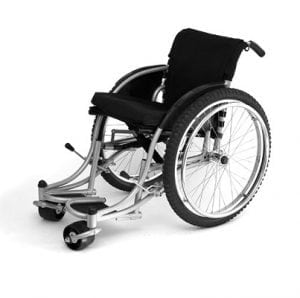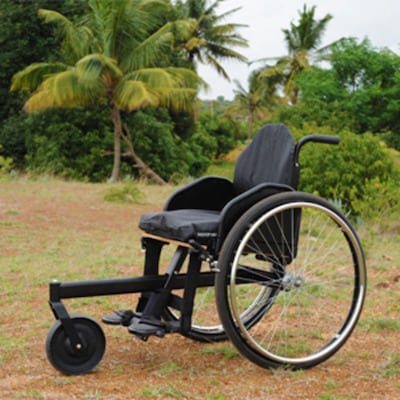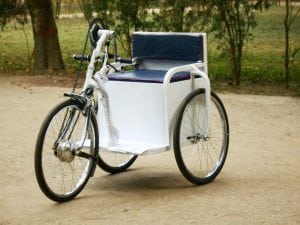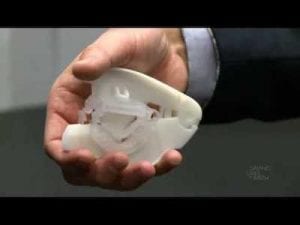
Agriculture
November 9, 2023

Updated on November 9, 2023
·Created on May 27, 2016
Motivation Rough Terrain Wheelchair is a 3-wheeled wheelchair designed for travel on uneven an rough surfaces.
Market Suggested Retail Price
$140.00
Target Users (Target Impact Group)
Distributors / Implementing Organizations
Motivation works with local partners, national governments, and humanitarian organizations (not listed) to help market and distribute their wheelchairs.
Manufacturing/Building Method
Intellectural Property Type
Trade Secret
User Provision Model
Motivation works with local partners, national governments, and humanitarian organizations (not listed) to help market and distribute their wheelchairs.
Distributions to Date Status
15,308 wheelchairs as of December 2015.
Technical Support
Replacement Components
Wheelchair is designed so the parts are easy to replace or repair and uses common wheel and bearing sizes.
Lifecycle
Designed for at least 5 years of service if properly maintained. The wheelchair and its packaging are designed for easy disassembly for recycling and reuse. No warranty information available.
Manufacturer Specified Performance Parameters
- - Active style, rough terrain wheelchair allowing either self or attendant propulsion over uneven and inclined ground. - - Designed so that parts are easy to replace or repair and uses common wheel and bearing sizes. - - The wheelchair can be individually assembled and fitted to each user by trained assemblers & prescribers. - - Designed for easy disassembly for recycling or reuse.
Vetted Performance Status
Unknown
Safety
Products are designed to be safe on rough terrains, but there is always a risk of the wheelchair falling over if the ground is too uneven.
Complementary Technical Systems
The wheelchair is designed to have adjustable/removable components to fit the needs of the user, but no additional products are listed.
Academic Research and References
WHO, ISPO, USAID report: Guidelines on the provision of manual wheelchairs in less resourced settings
Compliance with regulations
Motivation has worked with the World Health Organization to publish the Guidelines on the provision of Manual Wheelchairs in less resourced settings.
Other Information
One of the original designers, David Constantine, gives a TedTalk about the wheelchair and the thought processes behind the technology available here.

Agriculture
November 9, 2023

Agriculture
November 9, 2023

Agriculture
November 9, 2023

Agriculture
November 9, 2023
Agriculture
November 9, 2023
Agriculture
November 9, 2023

Agriculture
November 9, 2023

Agriculture
November 9, 2023

Agriculture
November 9, 2023

Agriculture
November 9, 2023
Have thoughts on how we can improve?
Give Us Feedback
Matt McCambridge says:
Dear E4C Staff, I’m posting based on the understanding that these comments are visible internally at E4C and not to general visitors to the site. If my understanding is incorrect please delete as these are intended to help E4C refine the comparison/evaluation.
Comments in order:
Manufacturing: chairs are manufactured in China and shipped flat-pack where they are assembled in-country
IP: not patent protected. blueprints not available to general public.
User Provision Model: add “Motivation emphasizes training in safe and appropriate wheelchair provision and works to connect local partners with WHO-approved training courses”
Distribution to date: Unknown. In volume production since 2004 at estimated 1,000-10,000 units per year (this is my best guess of range based on known clients. I’ll ask them to share actual number but in my experience they are not public with this info)
Matt McCambridge says:
Dear E4C Staff, I’m posting based on the understanding that these comments are visible internally at E4C and not to general visitors to the site. If my understanding is incorrect please delete as these are intended to help E4C refine the comparison/evaluation.
max rider: ok
seat width: ok
seat depth: Motivation material says adjusts for users measuring 43 to 54cm buttock to back of knee
adjustable seat: seat is settable permanently with tools at time of fitting.
Frame type: rigid not folding, but parts can be removed for transport/storage
Seat angle: you could say “90 degrees seat-back with 8 degrees of adjustment”. as written it is unclear seat to vertical or seat to back? if you mean seat to back angle, that is adjustable by 8 degrees on this product, I believe 90-98 but they do not specify.
footrest ht ok
repairable ok
chair weight: should be 22kg. 25kg includes packaging, extra mat’l typically discarded after fitting.
Fatigue tested: meets or exceeds ISO 7176-8. Tested by 3rd party to 200,000 cycles of Double Drum (endurance test subset of 7176-8). Tested by manufacturer to 400,000 cycles.
…
Replacement components: the link connects to pdf with multiple manufacturers products
vetted performance: current or past long-term customers include Latter Day Saints Charities, Handicap International, Walkabout Foundation, United Cerebral Palsy / Wheels for Humanity
Complementary technical systems: Customizable contoured multi-density pressure relief cushion included with every chair (this is worth mentioning, it’s safety critical and WHO recommends inclusion, but may not be distributed w all manufacturer’s wheelchairs
Optional handcycle attachment available.
Matt McCambridge says:
This reads as if someone with knowledge and interest in controlling electric motors went looking for a use for them, and decided on wheelchairs, without knowing anything about wheelchairs–either about the human factors or the mechanical issues. That is OK provided this person will partner with people/organizations who understand those things. they mention on the next page their partnership with the rehab hospital, if they truly allow these users to drive the design they might come up with something good. they should also involve people familiar with wheeled devices which survive in that environment–not necessarily wheelchairs, better perhaps to learn from rickshaws, bicycles, things which survive the terrain.
Given where these units will be deployed effective quality control is essential. For any unit to contain manufacturing defects or to arrive ‘dead-on-arrival’ at the customer is absolutely unacceptable. This requires both process control and appropriate testing during manufacturing as well as final assembly and test to ensure product quality. “checking In†quality after assembly will not be possible.